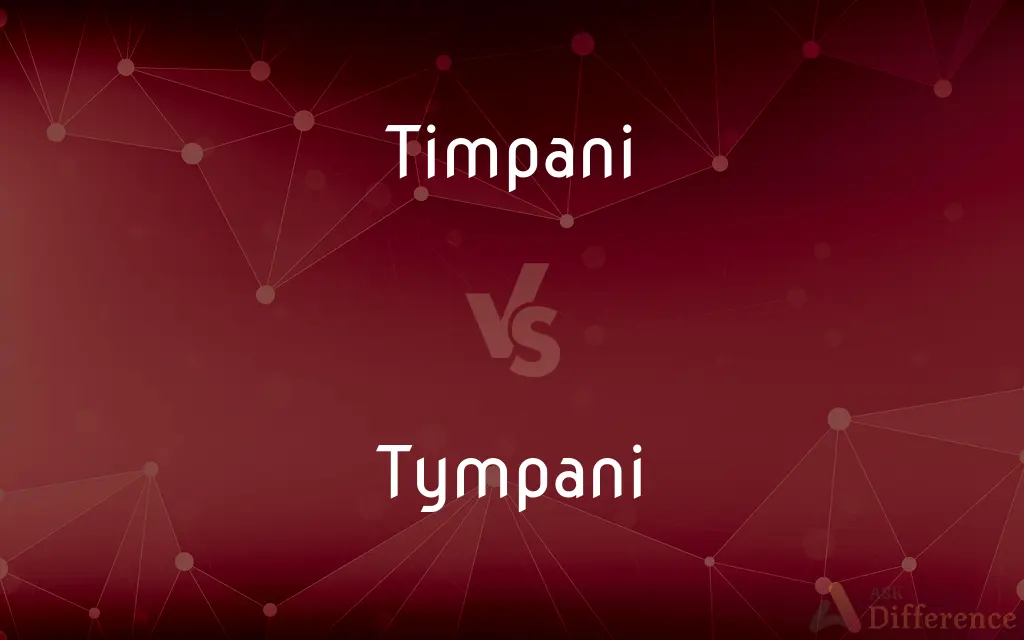Timpani vs. Tympani — What's the Difference?
By Tayyaba Rehman & Urooj Arif — Updated on April 8, 2024
Timpani, also known as kettledrums, are percussion instruments characterized by their large copper bowls and tunable pitches. "Tympani" is an older, less common spelling for the same instruments, reflecting its historical usage.

Difference Between Timpani and Tympani
Table of Contents
ADVERTISEMENT
Key Differences
Timpani are percussion instruments recognized for their distinctive large copper bowls and the ability to produce tunable pitches, a feature that sets them apart from many other percussion instruments. They play a crucial role in orchestral, concert band, and other musical ensembles, providing both rhythmic foundation and harmonic depth. On the other hand, "tympani" refers to the exact same instruments but is an alternative spelling that has fallen out of general use. This older form reflects the instrument's etymological roots but is less commonly seen in contemporary music literature.
The construction of timpani involves a copper bowl, a synthetic or animal skin head stretched over the top, and a mechanism for tuning the drum to specific pitches. This allows timpanists to adjust the pitch of the drum to fit the harmonic and rhythmic needs of the music being performed. Whereas, when discussing "tympani," one is referring to the same construction details and mechanisms, highlighting that the difference lies not in the physical characteristics or function of the instrument but in the spelling and historical usage of the term.
In modern orchestral settings, timpani are integral, with parts written specifically to utilize their unique sound and pitch range. Composers rely on these instruments for dramatic flourishes, rhythmic precision, and harmonic support. The term "tympani," while historically accurate, is less likely to be used in these modern contexts, demonstrating how language and terminology evolve in music as in other fields.
The role of the timpani in education and performance emphasizes not only musical skill and rhythmic accuracy but also an understanding of harmonic context, as players must often tune their drums in real-time to match the music's key. This aspect of timpani playing is identical, regardless of whether one uses the term "timpani" or "tympani," indicating that the primary difference between the two terms is etymological rather than functional.
The preference for "timpani" over "tympani" in contemporary musicology and performance practice underscores the dynamic nature of musical terminology. It reflects broader trends in language and the adoption of standard spellings for musical instruments and terms. This evolution in terminology does not alter the instrument's role or importance within ensembles but indicates a preference for consistency and clarity in musical nomenclature.
ADVERTISEMENT
Comparison Chart
Definition
Percussion instruments with tunable pitches, characterized by large copper bowls.
Alternative, historical spelling for the same instruments.
Usage
Preferred and commonly used in modern musical contexts.
Less common, reflecting older usage and spelling.
Construction
Copper bowl with a tunable membrane stretched over it.
Identical to timpani, no difference in construction.
Role in Ensembles
Provides harmonic depth and rhythmic foundation in orchestras and bands.
Same as timpani, with no difference in musical function.
Etymology and Spelling
"Timpani" is derived from the Italian "timpano" meaning a type of drum; modern standard spelling.
"Tympani" reflects an older English adaptation of the Italian "timpano".
Compare with Definitions
Timpani
Integral to orchestral and band music for rhythm and harmony.
The timpani added a powerful undertone to the orchestra's performance.
Tympani
Historical spelling for timpani, same instrument characteristics.
Mozart’s scores referred to the tympani for dramatic passages.
Timpani
Tunable percussion instruments with a copper bowl and membrane head.
The timpani player adjusted the pitch for the symphony's dramatic finale.
Tympani
Usage in historical texts and older music scores.
In early orchestral works, the tympani sections were crucial for rhythm.
Timpani
Played with mallets for various sound effects.
The composer requested soft mallets on the timpani for a gentle rumble.
Tympani
Reflects older English usage, identical in function.
The tympani part in Baroque music often underscored the harmony.
Timpani
Requires precise tuning and playing technique.
Learning to play the timpani involves mastering pitch control and dynamics.
Tympani
Represents the evolution of musical nomenclature.
Transition from tympani to timpani illustrates changes in spelling standards.
Timpani
Known for their dramatic and resonant sound.
The timpani's roll echoed through the concert hall, adding to the suspense.
Tympani
Same construction and role in music as timpani.
The tympani were tuned carefully before the performance began.
Timpani
Timpani (; Italian pronunciation: [ˈtimpani]) or kettledrums (also informally called timps) are musical instruments in the percussion family. A type of drum categorised as a hemispherical drum, they consist of a membrane called a head stretched over a large bowl traditionally made of copper.
Tympani
Alternative spelling of timpani.
Timpani
(musical instruments) The set of precision kettledrums in an orchestra.
Tympani
A large hemispherical brass or copper percussion instrument with a drumhead that can be tuned by adjusting the tension on it
Timpani
A large hemispherical brass or copper percussion instrument with a drumhead that can be tuned by adjusting the tension on it
Common Curiosities
What are timpani?
Timpani are tunable percussion instruments known for their large copper bowls and pitch flexibility, essential in orchestras and bands.
Why is "timpani" preferred over "tympani"?
"Timpani" is the modern standard spelling, reflecting current usage and terminology in music.
Is there a difference between timpani and tympani?
No, "tympani" is simply an older spelling of "timpani," referring to the same instruments.
How do you tune timpani?
Timpani are tuned by adjusting tension on the drumhead, typically using a pedal mechanism, to achieve the desired pitch.
What role do timpani play in an orchestra?
Timpani provide rhythmic foundation and harmonic depth, supporting dynamics and dramatic effects in orchestral music.
How many timpani are in a standard set?
A standard set often includes four timpani, allowing for a wide range of pitches and harmonic support.
Can timpani play melodies?
Yes, timpani can play melodies by tuning to different pitches and playing rhythmically complex parts.
Where did the timpani originate?
Timpani have roots in ancient cultures but were developed into their modern form in Europe, particularly in Italy.
What mallets are used for timpani?
Timpani mallets vary in hardness and material, chosen based on the desired sound, from soft and muffled to hard and articulate.
What skills are required to play timpani?
Playing timpani requires rhythmic precision, pitch accuracy, musicality, and the ability to adjust tuning quickly.
Do timpani have a solo repertoire?
Yes, there are solo compositions and concertos written specifically for timpani, showcasing their musical versatility.
How are timpani different from other drums?
Unlike most drums, timpani have tunable pitches, allowing them to play specific notes and contribute to the harmonic content.
Share Your Discovery

Previous Comparison
Date vs. Rendezvous
Next Comparison
Accretion vs. ConcretionAuthor Spotlight
Written by
Tayyaba RehmanTayyaba Rehman is a distinguished writer, currently serving as a primary contributor to askdifference.com. As a researcher in semantics and etymology, Tayyaba's passion for the complexity of languages and their distinctions has found a perfect home on the platform. Tayyaba delves into the intricacies of language, distinguishing between commonly confused words and phrases, thereby providing clarity for readers worldwide.
Co-written by
Urooj ArifUrooj is a skilled content writer at Ask Difference, known for her exceptional ability to simplify complex topics into engaging and informative content. With a passion for research and a flair for clear, concise writing, she consistently delivers articles that resonate with our diverse audience.















































